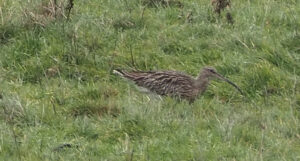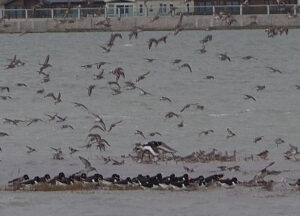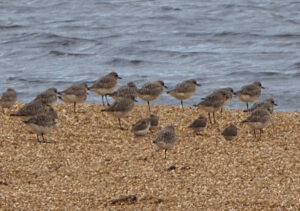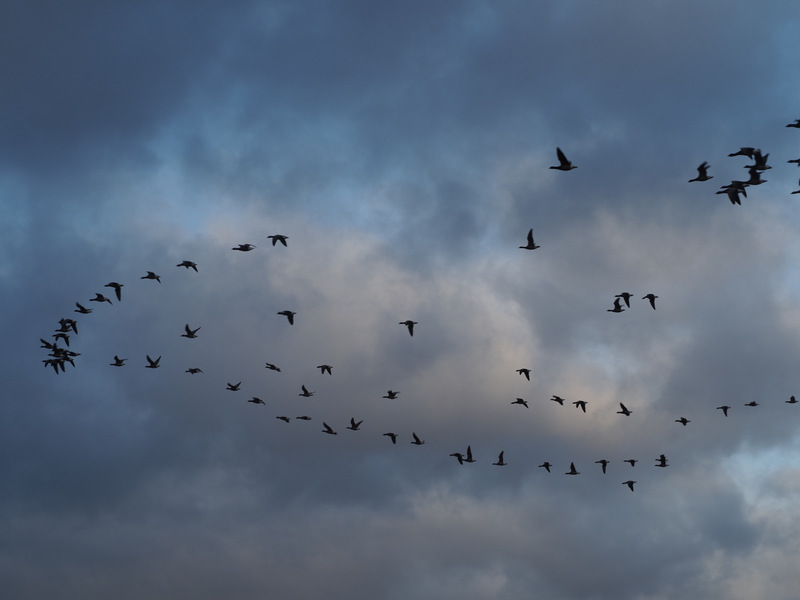Wow! We actually got to Farlington Marshes this year after cancellations previously through Covid, rain and sickness. Yipee! I was accompanied by Liz, Ian, Will, Brian and his extra strong mints and new member Tony on a chilly, grey but mainly rain free morning. The run down took about an hour and a quarter and after all that sitting in the cars we wanted to get straight out walking without the usual coffee start. Well, we walked about 1 yard before stopping to watch a group of Brent Geese and a small group of Black Headed Gulls who had been infiltrated by a couple of Common Gulls.

When we eventually set off properly I inadvertently gave the group an adventurous route onto the reserve whereby they had to ascend a steep muddy incline and worm round the end of a fence, avoiding the drop into the sea inlet. A Rock Pipit sat on a post amongst the seaweed obviously having a bit of a laugh at our antics. Everyone passed the assault course test and Brian even pointed out the entrance gate which I had totally missed. Once on terra firma we walked through some exciting damp scrub where Goldfinches, Greenfinches and a lonesome Chaffinch were feeding up in the bushes. A large flock of Lapwings and attendant Starlings passed overhead making a flappy beeline for the pastureland and ponds. This was a rich area for birds so we took our time scanning to see what we could find. Beyond the ponds were yet more Brent Geese and Canada Geese. There were Brents flying over making a lovely, cosy growling call which added to the atmosphere created by the wild calls of Curlew, Oystercatcher and Redshank. The latter two species were present in large, sleepy flocks which I was quite surprised at in Redshank which I had never before seen in such large groups. Avocets in the first big group we saw had found the water level too much even for their long legs and were gently bobbing up and down as they swam on the spot. Another good sized flock had the sense to find a shallower place.  The Curlews were Liz’s favourite bird of the trip and with the scope we were able to get some really close up views. Less easy to spot were three Snipe which are always great to find.
The Curlews were Liz’s favourite bird of the trip and with the scope we were able to get some really close up views. Less easy to spot were three Snipe which are always great to find.
We were happy to see a large number of duck on the open water in the pond areas especially when one large group turned out to be Pintail, probably about 30 altogether. We were equally pleased that Shelduck were there in good numbers along with beautiful Wigeon and Teal and a few splendid looking Mallard in top plumage. A small group of Gadwall skulked near a reedbed along with some Moorhens and Coots. Tony found our first Heron and Brian clocked a small bird zooming on to the top of a spiky plant on the pond bank, a Stonechat.
 Will next put me in the firing line as I had the scope. Out in the sea channel was a fast-disappearing islet. The tide was high and getting even higher. Lots of waders were zooming round the islet trying to claim squatters’ rites on the fast-receding shore. Long distance wader IDing is not my forte and I am always mentally wishing Mike Russell was with us in these situations but ………. I managed! Oystercatchers were easy but eventually I found large numbers of Grey Plover and a few Black Tailed Godwits. With Will’s help we worked out the tiny birds were all Dunlin. We had hoped for some Ringed Plovers amongst them but you can’t have everything.
Will next put me in the firing line as I had the scope. Out in the sea channel was a fast-disappearing islet. The tide was high and getting even higher. Lots of waders were zooming round the islet trying to claim squatters’ rites on the fast-receding shore. Long distance wader IDing is not my forte and I am always mentally wishing Mike Russell was with us in these situations but ………. I managed! Oystercatchers were easy but eventually I found large numbers of Grey Plover and a few Black Tailed Godwits. With Will’s help we worked out the tiny birds were all Dunlin. We had hoped for some Ringed Plovers amongst them but you can’t have everything.
Tiny dots on the seawater all turned out to be Great Crested Grebes no matter how much we tried to make them Great Northern or other species of Diver. The gulls were getting bigger here with both Herring and Great Black Backed passing over. The Brent Geese were ever present and as we scanned inland again we got into two raptors sitting on fence posts. One a Buzzard and the other a smart male Marsh Harrier. Tony had found the latter earlier so it was nice that we all ended up seeing this lovely bird.
 Liz decided to keep moving at this point because it was getting decidedly chilly by the sea. We followed on but got waylaid in an exciting area where raised sand banks had been made in the freshwater scrapes. Here we got really good views of Grey Plover and Dunlin all of which were having a chill out and not scurrying round like they usually do. Amongst the assorted ducks and ubiquitous Brent Geese were a new species, Shovelers. We all decided Liz had made a good choice and set off a bit more rapidly but still found a few additional species on route including Robin, Wren, Pied Wagtail, Dunnock and Great Spotted Woodpecker.
Liz decided to keep moving at this point because it was getting decidedly chilly by the sea. We followed on but got waylaid in an exciting area where raised sand banks had been made in the freshwater scrapes. Here we got really good views of Grey Plover and Dunlin all of which were having a chill out and not scurrying round like they usually do. Amongst the assorted ducks and ubiquitous Brent Geese were a new species, Shovelers. We all decided Liz had made a good choice and set off a bit more rapidly but still found a few additional species on route including Robin, Wren, Pied Wagtail, Dunnock and Great Spotted Woodpecker.
After a welcome picnic in the cars looking over the inlet of the sea we set off for a pit stop at Pagham Harbour in Church Norton. Here the tide was still too high for much wader activity at close quarters but it was lovely down there. The Great Northern Diver and Eider which had been there in the morning had discourteously moved on but we still saw a good lot of birds before leaving for the trip back home. We all agreed it had been a very good day out once again. One abiding memory being those lovely grunting Brent Geese flying around us.

Nigel